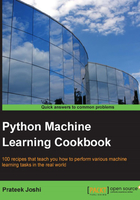
Estimating the income bracket
We will build a classifier to estimate the income bracket of a person based on 14 attributes. The possible output classes are higher than 50K or lower than or equal to 50K. There is a slight twist in this dataset in the sense that each datapoint is a mixture of numbers and strings. Numerical data is valuable, and we cannot use a label encoder in these situations. We need to design a system that can deal with numerical and non-numerical data at the same time. We will use the census income dataset available at https://archive.ics.uci.edu/ml/datasets/Census+Income.
How to do it…
- We will use the
income.pyfile already provided to you as a reference. We will use a Naive Bayes classifier to achieve this. Let's import a couple of packages:from sklearn import preprocessing from sklearn.naive_bayes import GaussianNB
- Let's load the dataset:
input_file = 'path/to/adult.data.txt' # Reading the data X = [] y = [] count_lessthan50k = 0 count_morethan50k = 0 num_images_threshold = 10000
- We will use 20,000 datapoints from the datasets—10,000 for each class to avoid class imbalance. During training, if you use many datapoints that belong to a single class, the classifier tends to get biased toward this class. Therefore, it's better to use the same number of datapoints for each class:
with open(input_file, 'r') as f: for line in f.readlines(): if '?' in line: continue data = line[:-1].split(', ') if data[-1] == '<=50K' and count_lessthan50k < num_images_threshold: X.append(data) count_lessthan50k = count_lessthan50k + 1 elif data[-1] == '>50K' and count_morethan50k < num_images_threshold: X.append(data) count_morethan50k = count_morethan50k + 1 if count_lessthan50k >= num_images_threshold and count_morethan50k >= num_images_threshold: break X = np.array(X)It's a comma-separated file again. We just loaded the data in the
Xvariable just like before. - We need to convert string attributes to numerical data while leaving out the original numerical data:
# Convert string data to numerical data label_encoder = [] X_encoded = np.empty(X.shape) for i,item in enumerate(X[0]): if item.isdigit(): X_encoded[:, i] = X[:, i] else: label_encoder.append(preprocessing.LabelEncoder()) X_encoded[:, i] = label_encoder[-1].fit_transform(X[:, i]) X = X_encoded[:, :-1].astype(int) y = X_encoded[:, -1].astype(int)The
isdigit()function helps us in identifying numerical data. We converted string data to numerical data and stored all the label encoders in a list so that we can use it when we want to classify unknown data. - Let's train the classifier:
# Build a classifier classifier_gaussiannb = GaussianNB() classifier_gaussiannb.fit(X, y)
- Let's split the data into training and testing to extract performance metrics:
# Cross validation from sklearn import cross_validation X_train, X_test, y_train, y_test = cross_validation.train_test_split(X, y, test_size=0.25, random_state=5) classifier_gaussiannb = GaussianNB() classifier_gaussiannb.fit(X_train, y_train) y_test_pred = classifier_gaussiannb.predict(X_test)
- Let's extract performance metrics:
# compute F1 score of the classifier f1 = cross_validation.cross_val_score(classifier_gaussiannb, X, y, scoring='f1_weighted', cv=5) print "F1 score: " + str(round(100*f1.mean(), 2)) + "%" - Let's see how to classify a single datapoint. We need to convert the datapoint into something that our classifier can understand:
# Testing encoding on single data instance input_data = ['39', 'State-gov', '77516', 'Bachelors', '13', 'Never-married', 'Adm-clerical', 'Not-in-family', 'White', 'Male', '2174', '0', '40', 'United-States'] count = 0 input_data_encoded = [-1] * len(input_data) for i,item in enumerate(input_data): if item.isdigit(): input_data_encoded[i] = int(input_data[i]) else: input_data_encoded[i] = int(label_encoder[count].transform(input_data[i])) count = count + 1 input_data_encoded = np.array(input_data_encoded) - We are now ready to classify it:
# Predict and print output for a particular datapoint output_class = classifier_gaussiannb.predict(input_data_encoded) print label_encoder[-1].inverse_transform(output_class)[0]
Just like before, we use the predict method to get the output class and the inverse_transform method to convert this label back to its original form to print it out on the Terminal.